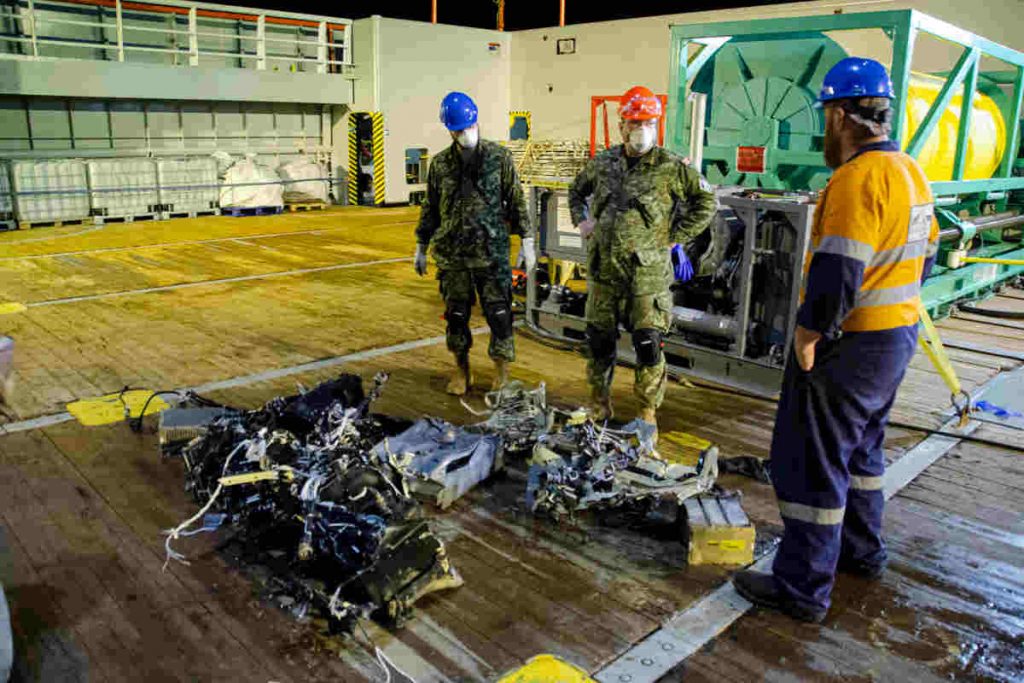
News
Helicopters
Military
Software issue contributed to naval helicopter crash that killed six
June 28, 2021 By Christopher Reynolds, The Canadian Press
 Canadian Armed Forces members and EDT Hercules personnel inspect recovered parts of Stalker 22 on May 31, 2020. (Photo: Cdr Robert Watt, Canadian Armed Forces)
Canadian Armed Forces members and EDT Hercules personnel inspect recovered parts of Stalker 22 on May 31, 2020. (Photo: Cdr Robert Watt, Canadian Armed Forces) OTTAWA — A military investigation has found that a software issue played a major role in the deadly crash of a Cyclone helicopter off the coast of Greece last year.
As a pilot guided the naval helicopter into a tight turn, a built-in autopilot took control and sent the aircraft into the Ionian Sea, killing all six personnel on board. The process played out even though the pilot received no training or cockpit indicators to warn of how the automation system would respond in that “very specific” circumstance, the Defence Department said in a release.
No ‘quick fix’ to cause of deadly military helicopter crash, procurement chief says
The crash of the Stalker 22 on April 29, 2020, marked the third incident involving a Cyclone, with defective software blamed for one of the helicopters’ suddenly dropping several hundred feet during a test flight in 2017. Another had a “hard landing” on a ship in February 2019.
Several restrictions were placed on the helicopters after the 2017 incident forbidding crews from performing certain manoeuvres.
The report lists several recommendations, including the need to modify flight control software and establish a working group to review operational requirements around complex turning manoeuvres for the new CH-148 Cyclone.
The Cyclones are typically deployed on board Canadian frigates and used for search and rescue, surveillance and anti-submarine warfare.
Master Cpl. Matthew Cousins, Sub-Lt. Abbigail Cowbrough, Capt. Kevin Hagen, Capt. Brenden MacDonald, Capt. Maxime Miron-Morin and Sub-Lt. Matthew Pyke died in the crash near their ship, the HMCS Fredericton.
The report says testing wasn’t done during the aircraft’s certification to identify what would happen if a pilot overrode the autopilot more than “momentarily” and in certain complex situations.
“The automation principles and philosophy that governed the Cyclone’s design never intended for the (autopilot) to be overridden for extended periods of time, and therefore this was never tested,” it states.
This was the case even though – as the report says – pilots are known on occasion to override the autopilot system without manually pressing a button on their control stick, called the cyclic.
The software issue was a key cause, but not the only one, said Brig.-Gen. John Alexander, director of flight safety at the Royal Canadian Air Force.
“This accident was not the result of one single causal factor, but a combination of several and could have happened to any other crew on any other day,” he said in a statement.
Other factors included the fact that standard operating procedures for the manoeuver were undocumented and that flying publications contained information that may have been “confusing or misleading,” the Defence Department said.
The autopilot response was “unknown to the manufacturer, airworthiness authorities, and aircrew prior to the accident,” Alexander said.
A stone monument was unveiled on the first anniversary of the crash, with a black granite, six-faced memorial now standing four feet tall at the entrance of Canadian Forces Base Shearwater in Nova Scotia.
Maj.-Gen. Eric Kenny said the air force has begun to implement the recommendations and remains “fully confident in the aircraft’s cutting-edge capabilities and those who fly and maintain them every day.”